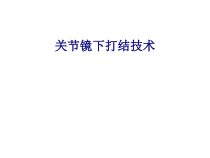 PPT
PPT
【文档说明】医学关节镜下打结技术培训课件.ppt,共(111)页,45.784 MB,由小橙橙上传
转载请保留链接:https://www.ichengzhen.cn/view-255828.html
以下为本文档部分文字说明:
关节镜下打结技术•Anincreasingnumberofsurgeonsareperformingarthroscopicsurgeryinthekneetorepairmeniscaltearsandintheshouldertorepairrotatorcuf
forlabraltears•Manyarealsoperformingcapsularshiftstotreatinstability.•Essentialtotheseproceduresistheabilitytotiearthroscopicknotstoapproximateintr
aarticularIntroduction•Thesurgeonmustsequentiallyconstructtheknotoutsidethejointandthenpasstheknotintothejointthroughsmallcannulas•Ty
ingarthroscopicknotsistechnicallydemandingandrequiresconsiderablepractice•Withthepopularityofarthroscopicsurgery,
thenumberofusedarthroscopicknotsandthenumberofsurgeonsusingtheseknotshasincreasedKnotTyingPrinciples•Thegoalofknottyi
ngistoapproximatetissueundertensionandmaintainthetissueinappositionuntilbiologicrepairandhealingcanoc
cur•Itisimperativeforallsurgeonstolearnanduseknot-tyingtechniquesthatminimizethechanceofknotfailure•Knotsecurityfriction,internalinterference,an
dslackbetweenthrows•Frictionisinherenttothesuturematerial•Internalinterferencetheconfigurationoftheknotandincreasedbythelengthofth
econtactbetweenthelooplimbandthepostlimb•slackbetweentheindividualthrowsineachknottomaximizeloopsecurity•slippagecan
leadtofailureoftissueappositionKnotTyingPrinciples◆fourdifferentprocessesofknotfailure➢knotslippageandlooseni
ng➢suturebreakage➢tissuefailure➢sutureanchorpulloutfrombone➢throughsuturebreakageKnotfailureKnotTerminology•postlimb(alsocommonlyknownastheaxiall
imb)•looplimb(alsocommonlyknownasthewrappinglimb,workingend,runningend,orfreeend)•Knotsareconstructedbytyingthelooplimbaroundthepostlim
b(Fig.1)FIGURE1.LoopandpostconfigurationArthroscopicKnotPushers•Anarthroscopicknotpusherisadeviceusedtoadvancetheloopdownthepostlimbintothe
jointtocreatetheknot.Arthrexknotpushers.A.Single-hole,B.Double-hole,C.6thFingerFIGURE3.Mitekknotpushers.A.Single-hole,B.Doub
le-hole,C.Slotteddouble-holeknotpushersanddoublediameterknot•double-holeknotpushersanddoublediameterknotpushersliketheArt
hrex6thFinger(Arthrex,Naples,FL).Double-diameterknotpushersprovidebetterloopsecuritycomparedtostandardsingle-holeknotpushersDouble-holeknotpusherFIGU
RE4.Double-holeknotpusher.HowtoUsetheDouble-DiameterKnotPusherFIGURE5.A-F.TyingknotswiththeArthrex6thfingerSutureProperties
•Twotypesofsuturesarecommonlyusedintyingarthroscopicknots:apermanent,braided,polyester,nonabsorbablesutureandanabsorbable,mon
ofilamentsuture•Examplesofpermanent,braided,polyester,nonabsorbablesuturesareEthibondandTicron•Examplesofabsorbable,monofilamentsuture
sarePDSII,polydiaxononeandMaxon,polyglyconate•Braidedpolyesterhasincreasedpliability,ductility,ahighercoefficientoffrictionandgreaterstrength
thandoesabsorbablemonofilament•Becausethebraidedsutureismorepliable,thevolumeoftheknotisdecreasedandtheseknotscanbeci
nchedtighter.KnotstiedwithEthibondwereshowntobestrongerwhencomparedtoPDSIIinseveralbiomechanicalstudies•However,braidedpolye
stermayfraywithexcessivehandling,whichmayleadtosuturerupture◆Braidedpolyestersuturemaybecoatedto:➢improvesu
rgeonhandling➢reducefrictionbetweenthesutureandsurroundingtissue,whichcanleadthetissuedamage➢decreasefrictionbetweensuturelimbs,whichm
ayleadtofraying➢However,suturecoatingdecreasesthecoefficientoffrictionoftheknot,whichtheoreticallyincreasestheriskofkno
tslippage•Knotstiedwithabsorbable,monofilamentsuturesareeasiertoslidedownapostanddonotfray•Thereislessfrictionbetweenthesutureandsu
rroundingtissueleadingtolesspotentialtissuedamagewhenthesutureispulledthroughthetissue•absorbablesuturesdissolv
eanddonotleaveknotsthatmaycauseapersistentinflammatoryreactionaftertissuehealing•Absorbablesuturescanapposetissueunderstressfora
pproximatelysixweekswithcompleteabsorptionoccurringinapproximatelysixmonths•However,absorbablemonofilamentsuturesarehardertohandlethanp
olyestermakingitmoredifficulttokeepknotstightandsecure•Also,aabsorbablemonofilamentsuturewillfailearlierwithcyclicloadingth
anpolyestersutureandmayexpandbyplasticdeformationmorethan30%ofitslengthbeforebreaking•Thesizeofthesutureisalsoafactorin
determiningaknot'sholdingcapacityandalsothetensilestrengthofthesutureitself•Clinicalfailureofallknotsandsuturetypesimprovedby100%whe
nsuturesizewasincreasedby2gaugesUSP(U.S.Pharmacopeia.•ThesizesuturemostcommonlyusedinarthroscopicsurgeryisNo.1orNo.2
.KnotTypes•Thereareavarietyofknotincludenonslidingknots,slidingknots,andlockingknots.•Nonslidingknotsareknotsthatdonotslidethou
ghthetissuesbeingapposed.TheyincludethesquareknotandknotsconsistingofaseriesofhalfhitchesliketheRevoknot(34)•Althoughthesq
uareknotfailsathigherloadsthandoseriesofhalfhitchesinhand-tiedknots(38),thesquareknotisnotcommonlyusedart
hroscopically.•Thesquareknotisaflatknotinwhichbothstrandsenterandleavetheknotparalleltoeachother(Fig.6).•Inor
dertotieasquareknot,symmetrictensionmustbesimultaneouslyappliedtoeachlimb,whichisdifficulttodoarthroscopically•Ifasymmetrictensionisapplied
tooneofthelimbs,theknotconvertstotwononidenticalhalfhitches•Thus,mostarthroscopicsurgeonspreferusingase
riesofhalfhitchesFIGURE6.Squareknotconfiguration.•Slidingknots,liketheDuncanloop(27),areusefulinopposingtissueundert
ension.Whiletyingaslidingknot,thepoststrandisheldundertensionwhiletheloopstrandistiedaroundit.Becausethepoststrandisnotincorporatedintothes
tructureoftheknot,theknot,oncetied,caneasilymovedownthepostresultinginaslidingknotinsteadofaflatknotsuchasthesquareknot.•Oncethesl
idingknotsareseated,theyareoftenlockedwithaseriesofhalfhitches.Someslidingknotspreferentiallyslideinonlyonedirection•A
lockingknotisamodificationofaslidingknot•Asimpleslidingknotcanloosenbeforeaseriesofhalfhitchesarethrownto“lock”the
slidingknotinplace•lockingknots(alsoknownasflipknots)havebeendevelopedtomaintaininitialloopsecuritythatdoesnotloosenwhentensionisre
moved•Thepoststrand“flips,”convertingtheloopstrandintothenewpoststrandandlockingtheknotintoplace.Anexampleofalocking
knotistheSMCknot.lockingknotsdonotneedtobesupplementedwithaseriesofhalfhitches•Theauthorsofthismanualhavefoundlockingknotswithoutr
einforcinghalfhitchestobeinferiorintensilestrengthtoknotsreinforcedwiththreereversedhalfhitchesonalternatingposts(unpublisheddata)•Lockingandsli
dingknotscanbeadvancedintothejointjustbypullingonthepost.Thiscancausetensionattherepairsite,whichcandamag
ethetissuebeingapposed.Tensionattherepairsitecanbeminimizedbypushingtheknotaheadwiththeknotpusherwhilesimultaneouslypullingont
hepostlimb.Withlockingandslidingknots,itisimportantthatthelooplimbisatleasttwiceaslongasthepostlimb.Ifiti
snot,whenpullingthepostlimbtoadvancetheknotthroughthecannulaandintothejoint,theshortenedlooplimbmaybepulle
dintothecannulamakingitimpossibletosecuretheknot.•Whenusingaslidingorlockingknotconfiguration,itisimportanttoensurethatthesutureslidese
asilythroughthetissuebeingopposed.Ifthesuturedoesnotslideeasily,thesurgeonshouldconsiderusinganonslidingknot.KnotPushing
andPulling•Knotconfigurationscanbeeitherpushedorpulledintothejoint.hearthroscopicknot-tyingdeviceispositionedonthelooplimban
disadvancedpastthehalfhitchthuspullingtheloopoverthepostlimbintothejoint(Fig.7A).•Thearthroscopicknot-ty
ingdeviceispositionedonthepostlimbbehindtheknotthuspushingtheloopoverthepostlimbintothejoint(Fig.7B).FIGURE7.A.Knotp
ulling,B.Knotpushing.TyingHalfHitches•Usingtheonehandknot-tyingtechnique,halfhitchescanbetiedeitherunderhandoroverhand•Thefollowinginstruc
tionsdefineanunderhandloopandanoverhandloopFIGURE8.A-E.Underhandhalfhitch.ConfigurationofHalfHitches•Halfhitchescan
bethrowninthesamedirection(twosuccessiveoverhandhitches)orcanbethrowninoppositedirections(anoverhandhitchfollowedbyanun
derhandhitch)•Halfhitchescanalsobetiedonoppositeposts.TeraandAberg(37)developedanomenclaturefordescribingfl
atknots.PostSwitchingFIGURE13.A.Parallelloopandpostlimbs.B.Parallelloopandpostlimbswitha“flat”knot.FIGURE14.A.Twistedloop
andpostlimbs.B.Whentyingaknotwithtwistedpostandlooplimbs,theknotdoesnotlie“flat.”C.Thefinalknotconfigurationwilllooseniftheknotistiedwhentheloop
andpostlimbsaretwisted.•ChanandBurkhartdescribedamayincreasethespeedoftheknot-tyingprocessandalsohelplimittw
istingofthesuturelimbs.Onecan“flip”ahalfhitchbyreleasingtensiononthepostlimbandpullingonthelooplimb.•Whenthepostissw
itched,thedirectionofthehalfhitchisalsoreversed.Theauthorsofthistechniquereportthatitiseasiertofliphal
fhitchesusingmonofilamentbecauseitmorereadilyconvertstoaflatknot,butitcanalsobedonewithbraidedsuture.•Holdthepostinthenondominanth
andandtheloopinthedominanthand(Fig.15A).•Movetheoriginalpostforwardandaheadofthehalfhitch.•Applyparalleltractiono
nthepostandloopsimultaneouslyconvertingthehalfhitchtoaflatknot(Fig.15B).•Applyaxialtractiontothelooplimbconvertingitintothenewpostlimbandthehalfhitch
isreversed(Fig.15C).PostSwitchingTechniqueFIGURE15.A-C.PostswitchingtechniqueArthroscopicKnot-TyingTechniques•
Itisimportanttodetermineifthesutureslidesthroughthetissueandsutureanchorpriortoknottying.Ifthesuturedoesnotreadilyslide,aslidingorlockingknotsho
uldnotbeusedandanonslidingknotshouldbechosen•Onlyonepairofsuturesshouldbewithintheworkingcannuladuringarthroscopickno
ttying.Ifmorethanonepairofsuturesarewithintheworkingcannuladuringtying,thereisahighlikelihoodthatthesutureswillbecometwistedandknottyingw
illbecomequitetediousifnotimpossible.Additionalsuturesshouldbeshuttledviaamonofilamentsuture(lesstissueabrasion)orbyanarthroscopicgraspertoa
naccessoryportal•Transparentcannulasarerecommendedforarthroscopicknottying.Thesecannulasallowthesurgeontoseeifthereisanytwistingofthesu
turestrandspriortoknottying•Thearthroscopicsurgeonshouldensurethatthereisnoredundantsofttissuearoundthetissuebei
ngapposedorinthepathofthesuturelimbsbecausethiswillimpedeknottyingandincreasethelikelihoodofknotfailure•Whentyinghalfhitcheswithasta
ndardsingle-holeknotpusher,thefirstthrowcommonlyslipswhentheknotpusherisremovedinpreparationfortheseco
ndthrow•Whenthesecondthrowisadvanced,thereisachancethatthehitcheswilllockpriortocompleteappositionofthetissue•To
preventthis,thesurgeoncanthrowthefirsttwohitchesinthesamedirectionallowingthehitchestoslidedowntheposttoapposethetissue•Anothe
rmethodofpreventinginitiallooplooseningistouseadouble-diameterknot-pushingdevice,suchastheArthrex6thtomaintaintensionontheinitialhitchwhi
lethrowingthesecondhitchNon-SlidingKnotsFIGURE16.A-F.Squareknot.RevoKnot•TheRevoknotisaseriesofmultiplehalfhitchesmadebyalternatingthepostandd
irectionofthehalfhitches.TherehavebeenseveralmodificationstotheRevoknotFIGURE17.A-H.OriginalRevoknot.•TheOriginalRevoknotconsistsoft
woreversedhalfhitchesonanidenticalpostfollowedbypostswitchingandtworeversedhalfhitches.•Throwanoverhandlooparound
thepost(Fig.17A).•Pulltheloopintothejointwiththeknotpusheronthelooplimb(Fig.17B)•Withdrawtheknotpusherwhilem
aintainingtensiononthepostlimb.•Throwanunderhandlooparoundthesamepost(Fig.17C)•Pulltheloopintothejointandseatth
eknotwiththeknotpusher.Oncethetwohitchesareseated,past-pointtocinchtheknotdown(Fig.17D).•Switchpostsandthrowanu
nderhandlooparoundthenewpost(Fig.17E).•Pulltheloopintothejoint,seattheknotwiththeknotpusher,andpast-pointtocinchtheknotdown(Fig.17F).•Next,t
hrowanoverhandlooparoundthepost(Fig.17G).•Pulltheloopintothejoint,seattheknotwiththeknotpusher,andpast-pointtocinchtheknotdown.(Fig.17H)Snyder'
sKnotSnyder'sKnot•Snyder'sisanothervariationoftheRevoknot•Throwanoverhandlooparoundthepost(Fig.18A).•Pulltheloopintothejointwiththeknotpus
heronthelooplimb(Fig.18B)•Withdrawtheknotpusherwhilemaintainingtensiononthepostlimb.•Throwanunderhandlooparoundthesame
post(Fig.18C)•Pulltheloopintothejointandseattheknotwiththeknotpusher.Oncethetwohitchesareseated,past-pointtocinchtheknotdown(Fi
g.18D).•Switchpostsandthrowanoverhandlooparoundthenewpost(Fig.18E).•Pulltheloopintothejoint,seattheknotwiththeknotpush
er,andpast-pointtocinchtheknotdown(Fig.18F).•Next,throwanunderhandlooparoundthepost(Fig.18G).•Pullthel
oopintothejoint,seattheknotwiththeknotpusher,andpast-pointtocinchtheknotdown(Fig.18H).•Switchpostsandthrowanoverhandlooparoun
dthenewpost(Fig.18I).•Pulltheloopintothejoint,seattheknotwiththeknotpusher,andpastpointtocinchtheknotdon(Fig18J)FIGURE19.A-K.Revoknot.•ThecurrentRe
voknotisamodificationoftheOriginalRevoknot•Throwanunderhandlooparoundthepost(Fig.19A).•Advancetheloopwiththeknotpusheronthel
ooplimbuntilthefirsthalfhitchisseated(Fig.19B).•Withdrawtheknotpusherwhilemaintainingtensiononthepostlimb.•Throwanotherund
erhandlooparoundthesamepost(Fig.19C).•Pulltheloopintothejointandseattheknotwiththeknotpusher.Oncethetwohitchesareseated,past-pointtocincht
heknotdown(Figs.19D,E).•Throwanoverhandhalfhitcharoundthepostandadvancewiththeknotpusher(Fig.19F).•Furthertensionbypastpointingandappl
ytensiononbothlimbswhileholdingthe(Fig.19G).•Switchpostsandthrowanunderhandlooparoundthenewpost(Fig.19H).•Pulltheloopintothejoint,seattheknotwith
theknotpusher,andpastpointtocinchtheknotdown(Fig.19I).•Switchpostsandthrowanoverhandlooparoundthenewpost(Fig.19J).•Pu
lltheloopintothejoint,seattheknotwiththeknotpusher,andpastpointtocinchtheknotdown(Fig.19K).SlidingKnots•OverhandThrowDuncanLoop•TheDuncanloopwaso
riginallydescribedinthefishingliterature(Uni-Knot)andhasbeenmodifiedforuseinarthroscopicsurgery.ThearthroscopicDu
ncanloopisalsoknownastheFisherman'sknotortheHangman'sknotThedifferencebetweenthefishingknotandthearthr
oscopicknotisthedirectiontheloopstrandtravelsaroundthepost.WhentyingthefishingDuncanloop,onewrapsthelooplimbaroundthepostinadirectionawa
yfromthejoint.TotiethemodifiedDuncanlooporHangman'sknot,thesurgeonsequentiallywrapsthelooplimbaroundthepostinadi
rectiontowardthejointFIGURE21.A-F.FishingDuncanloop.BerkleyDuncanLoopKnotArthroscopicDuncanLoop(Hangman'sKnot)(Fig.22)FIGURE22.A-
F.ArthroscopicDuncanloop.Frenchknot.FIGURE23.A-H.FIGURE23.A-H.Frenchknot.•TheFrenchknot(22)isaslidingknotthatisamodificationoftheDuncanl
oop.•Makethepostlimbhalfaslongasthelooplimb.•Graspthesuturesbetweenthethumbandindexfingerofyournon-dominanthand(Fig.23A).•Createasmallcircleintheloop
strandbypassingtheloopoverthecombinedpostandloopstrandsandholditbetweenyourthumbandindexfinger(Fig.23B).•Makeatotaloffour
loopsaroundboththepostandthelooplimbstravelingtowardthejoint(Fig.23C).•Passthetailoftheloopstrandoverandthroughthesmallcirc
leintheloopstrandthatisheldbetweenthethumbandindexfinger(Fig.23D).•Passthetailoftheloopstrandunderandthroughtheloopcirclecreatedbythedistalendofthelo
opstrandandthecombinedlimbsoftheloopandpoststrands(Fig.23E).•Pullonboththelooplimbandthepostlimbsymmetricallytotightentheknot(Fig.
23F).•Advancetheknotbypullingonthepostlimbwhilepushingtheknotdownwiththeknotpusheronthepoststrand(Fig.23G).•
Locktheknotwithaseriesofthreealternatinghalfhitcheswithpostswitching(Fig.23H).–Throwanunderhandloopontheoriginalpost.Tensionwiththe
knotpusher.–Switchposts.–Throwanoverhandloopoverthenewpost.Tensionwiththeknotpusher.–Switchposts.–Throwanunderhandloo
pontheoriginalpostagain.Tensionwiththeknotpusher.•TheFrenchknotwasshowntohaveahigherloadtofailurewhen
comparedtotheDuncanloopandtheRevoknotRoederKnot•TheRoederknotisaslidingknotthatisavariationoftheDuncanloop.Itwasoriginally
usedintonsillectomysurgeryanddescribedintheGermanliteraturebyRöderin1918•Therehavebeenseveralmodificationsoftheknotthathavebeendescribe
dsincetheinitialdescriptionoftheknot.ModificationsoftheRoederknotarecurrentlyusedinbothlaparoscopicandarthrosco
picsurgeryFIGURE24.A-G.Roederknot.•Thepostlimbshouldbeonehalfthelengthofthelooplimb.•Throwthefirstlooparo
undthepostlimbandthenholdtheloopandposttogetherwiththethumbandindexfingerofthenon-dominanthand(Fig.24A).•Throwasecondlooparoundboththepostandlooplim
bs(Fig.24B).•Throwathirdlooparoundonlythepostlimbandbetweenthepostandloop(Fig.24C).•Passthetailoftheloopbetweenthesecondandthirdturn
sandinbetweenthelooplimbandthepostlimb(Fig.24D).•Tensiontheknotbygentlypullingonboththepostandthelooplimbssimultaneously(Fig.24E).•Wh
ilepullingonthepostlimb,pushtheknotintothejointwiththeknotpusheronthepoststrand(Fig.24F).•Locktheknotwithaseriesofthreealternatinghalfhitcheswithpos
tswitching(Fig.24G).–Throwanunderhandloopontheoriginalpost.Tensionwiththeknotpusher.–Switchposts.–Throwanoverhandloopoverthenewpost.Tensio
nwiththeknotpusher.–Switchposts.–Throwanunderhandloopontheoriginalpostagain.Tensionwiththeknotpusher.•TheRoederknotwasshowntobei
nferiortotheDuncanloopandtheSnyderknotinloadtoclinicalfailuretrialsbutastatisticalsignificancewasnotfound(26).Savoie-Modif
iedRoederKnot(Fig.25)•TheSavoie-ModifiedRoederknotisalockingknotinsteadofaslipknot•Thepostlimbshouldbeonehalfthelengthoftheloop
limb.•Throwanunderhandlooparoundthepoststrand(Fig.25A).•Throwasecondlooparoundboththepostandlooplimbs.Besureto
leaveasmall“hole”inthelooppriortothrowingthesecondloop(Fig.25B).•Throwathirdlooparoundboththepostandl
ooplimbs(Fig.25C).•Throwafourthlooparoundboththepostandlooplimbs(Fig.25D).•Wrapthelooplimbaroundonlythepostandb
ringitawayfromthejoint(Fig.25E).•Passthetailofthelooplimbbetweenthe“hole”madeinstepC(Fig.25F).•Looselytensiontheknotbutdonotpullontheloopstr
andorthiswillprematurelylocktheknot(Fig.25G).•Whilepullingonthepostlimb,pushtheknotintothejointwiththeknotpusheronthepoststrand.•Whe
ntheknotisseated,pushdownontheknotpushertoholdtheknotinplaceandwhilemaintainingtensiononthepoststrand,pullontheloopstra
ndtolocktheknot.Thiswillpreventtheknotfromlooseningoncetensionisreleasedfromthestrands(Fig.25H).•Locktheknotwithaseriesofthreea
lternatinghalfhitcheswithpostswitching(Fig.25I)Lieurance-ModifiedRoederKnot(Fig.26)FIGURE26.A-H.Lieurance-ModifiedRoederknot.•T
heLieurance-ModifiedRoederknotisalockingknotinsteadofaslipknot•Thepostlimbshouldbeonehalfthelengthofthelooplimb.•Throwanoverhandlooparoundon
lythepoststrand(Fig.26A).•Throwasecondloopacrossboththepostandlooplimbs(Fig.26B).•Throwathirdloopacrossboththepostandlooplimbs(Fig.26C).•Wrap
thelooplimbaroundthepostonlyandbringitbetweenthepostandlooplimbs(Fig.26D).•Passthetailofthelooplimboverandthroughtheinitialloopmadebythepostandlo
oplimbs(Fig.26E).•Looselytensiontheknotbutdonotpullontheloopstrandorthiswillprematurelylocktheknot(Fig.26F).•Whilepull
ingonthepostlimb,pushtheknotintothejointwiththeknotpusheronthepoststrand.•Whentheknotisseated,pushdownontheknotpushertoholdtheknotinplaceandwhilemain
tainingtensiononthepoststrand,pullontheloopstrandtolocktheknot.Thiswillpreventtheknotfromlooseningoncetensionisreleasedfromthes
trands(Fig.26G).•Locktheknotwithaseriesofthreealternatinghalfhitcheswithpostswitching(Fig.26H)LaparoscopicRoederKnot(Fig.27)Tennes
seeSlider(Fig.28)FIGURE28.A-F.TennesseeSlider.•TheTennesseeslider(27)isabunt-linehitch,aknotinitiallyusedinsailing,wit
hhalfhitchesthrowninalternatedirectionsonoppositeposts.•Thepostlimbshouldbeapproximatelyhalfthelengthofthelooplimb.•Throwtheloopoveranda
roundthepostlimb(Fig.28A).•throwtheloopstrandaroundthepostlimbclosertothejointthantheprecedingloop(Fig.28B).•Passthetailo
ftheloopstrandthroughtheinitialloop(Fig.28C).•Tensiontheknotbygentlypullingbothsuturelimbssimultaneously(Fig.
28D).•Pushtheknotintothejointwiththeknotpusherwiththeknotpusheronthepoststrandwhilesimultaneouslypullingonthepoststrand(Fig.28E).•Locktheknotw
iththreealternatinghalfhitcheswithpostswitching(Fig.28F).EasyKnot(Fig.29)FIGURE29.A-E.Easyknot•TheEasyknotisaslidingknotthatconsistsofa
seriesoffiveoverhandhalfhitchesthatislockedwithanoverhandhitchontheoppositepost(2).•Thepostlimbshouldbeapproximatelyhalfthelengthoftheloopl
imb.•Throwanoverhandhalfhitcharoundthepost(Fig.29A).•Throwfouridenticaloverhandhalfhitches.Eachhalfhitchshouldbethrowndistal(fartherfromthejoin
tandarthroscopiccannula)thanthepreviousthrow(Fig.29B).•Tensiontheknotbygentlypullingsimultaneouslyonboththepoststrandandloopstrandsimultaneously
.•Pushtheknotintothejointwiththeknotpusheronthepoststrandwhilesimultaneouslypullingonthepost(Fig.29C).•Switchposts.•Throwanoverhand
halfhitcharoundthenewpost(Fig.29D).•Advancethelockinghalfhitchbypullingthehitchintothejointwiththekn
otpusherontheloopstrandandpastpointtocinchtheknotdown(Fig.29E).LafosseKnot(Fig.30)FIGURE30.A-J.Lafosseknot•TheLafosseknotissimilar
instructuretotheEasyknotbutincorporatesthepostswitchingtechnique.•Thepostlimbshouldbeapproximatelyhal
fthelengthofthelooplimb.•Throwanoverhandhalfhitcharoundthepostwhilemaintainingtensiononthepoststrand(Fig.30A).•Throwfouridenticaloverhandhalfhi
tches.Eachhalfhitchshouldbethrowndistalthanthepreviousthrow.Ensuretomaintaintensiononthepoststrand(Fig.30B).•Pushtheknotin
tothejointwiththeknotpusheronthepoststrandandwhilesimultaneouslypullingonthepost(Fig.30C).•Crosstheknot
pusherovertheloopstrandattheleveloftheknot,pulltensionontheloopstrand,andpast-point.Thiscausestheposttoswitchandthelasthitchreversestolockthe
slidingknot(Fig.30D).•Atthispoint,iftheknotisnottightenough,pullontheinitialpostandthehalfhitchreversesthe
rebyunlockingtheknot.Theknotcanbefurthertightenedbypullingonthepostandpushingtheknotdownwiththepusher.Theknotcanberelock
edinthemannerdescribedinstepE.•Throwanoverhandhalfhitcharoundthesamepost(Fig.30E).•Withtheknotpusheronthepoststrand,advancethelo
ckinghalfhitchbypushingthehitchintothejointwiththeknotpusher(Fig.30F).•Crosstheknotpusherovertheloopstran
dattheleveloftheknot,pulltensionontheloopstrand,andpast-point.Thiscausestheposttoswitchandthehitchtoreversedirections(Fig.30G).•Thr
owasecondoverhandhalfhitcharoundthesamepost(Fig.30H).•Withtheknotpusheronthepoststrand,advancethelockinghalfhitchbypushingthehitchintothejointwit
htheknotpusher(Fig.30I).Double-TwistKnot(Fig.31,32)FIGURE31.A-C.Double-twistknot.•Thedouble-twistknot(31)isaknotthatemploysadoublesuturestit
ch.Itcanbeusedwithasutureanchororwhendoingaside-to-siderotatorcuffrepair(Fig.31).•Asutureisdoubledoverandthelimbs
arepassedthruthesofttissuesandboththeloopandtwostrandsareretrievedfromthecannula(Figs.32A,B).•Eachstr
andistwistedclockwisearoundthelooptwice(Fig.32C).•Pullonbothlimbssimultaneouslytoadvancetheknot(Figs.32D,E,F).•Usetheknotpusheroneachlimbtoadvancet
heloopdownwhileeachstrandisalternatelypulled(Figs.32G,H,I)•Locktheknotwithaseriesofthreealternatinghalfhitcheswithpostswitching(Fig.32J
).–Throwanunderhandloopontheoriginalpost.Tensionwiththeknotpusher.–Switchposts.–Throwanoverhandloopoverthenewpost.Tensionwiththeknotpusher.–Switchpos
ts.–Throwanunderhandloopontheoriginalpostagain.Tensionwiththeknotpusher.FIGURE32.A-J.Double-twistknot.•TheDouble-twistknotwasshowntohaveasign
ificantlyhighermeanpeaktofailurecomparedtotheTennesseeSliderandSnyder'sknot(31).Nicky'sKnot(Fig.33)FIGURE33.A-F.Nicky'sk
not.•Nicky'sknot(9)isaone-wayslipknot.ItisamodificationoftheTautlinehitch(16,41).•Thepostlimbshouldbeapproximatelyhalfthelen
gthofthelooplimb.•Throwanoverhandhalfhitcharoundthepost(Fig.33A).•Makeasecondoverhandhalfhitchproximal(closertothearthrosco
piccannula)tothefirstthrow(Fig.33B).•Bringtheloopstranddistal(closertotheendsofthesuture)tothetwoloopsandmakeathirdoverhandh
alfhitch(Fig.33C).•Tensiontheknotbygentlypullingonbothlimbssimultaneously(Fig.33D).•Pullonthepoststrandwhilepushingtheknotwiththeknotpusheron
thepoststrand(Fig.33E).•Locktheknotwithaseriesofthreealternatinghalfhitcheswithpostswitching(Fig.33F).–Thr
owanunderhandloopontheoriginalpost.Tensionwiththeknotpusher.–Switchposts.–Throwanoverhandloopoverthenewpost.Tensionwith
theknotpusher.–Switchposts.–Throwanunderhandloopontheoriginalpostagain.Tensionwiththeknotpusher.ModifiedTautLineHitch(Fig.34)•Thepostlimbshouldbe
approximatelyhalfthelengthofthelooplimb.•Makeanoverhandhalfhitcharoundthepost(Fig.34A).•Makeasecondoverhan
dhalfhitchproximal(closertothejoint)tothefirstthrow(Fig.34B).•Bringtheloopstranddistal(fartherfromthejoint)tothetwoloopsandmakeathirdoverhan
dhalfhitch(Fig.34C).•Makeanotheroverhandhalfhitchproximaltothethirdoverhandthrowbutdistaltothefirstoverhandthrow(Fig.34D)
.•Tensiontheknotbygentlypullingonbothlimbssimultaneously.•Pullonthepoststrandwhilepushingtheknotwiththeknotpush
eronthepoststrand(Fig.34E).•Locktheknotwithaseriesofthreealternatinghalfhitcheswithpostswitching(Fig.34F).•Throwanunderhandloopontheoriginalp
ost.Tensionwiththeknotpusher.•Switchposts.•Throwanoverhandloopoverthenewpost.Tensionwiththeknotpusher.•Switchposts.•Throwanunderhandloop
ontheoriginalpostagain.TensionwiththeknotpusherLockingKnots•FieldKnot(Fig.35)•TheFieldknot(11)isaloc
kingknotthatisamodificationoftheSavoie-ModifiedRoeder.Althoughalockingknot,theoriginatorsofthisknotrecommendfurtherreinforcingitwithaseriesofthre
ehalfhitches.•Thepostlimbshouldbeonehalfthelengthofthelooplimb.•Throwanoverhandloopoverthepoststrand(Fig.35A).•Throwasecondlooparoundbothth
epostandlooplimbs.Besuretoleaveasmall“hole”inthelooppriortothrowingthesecondloop(Fig.35B).•Throwathirdlooparoundboththepostandlooplimbs(Fig.35
C).•Wrapthelooplimbaroundonlythepostandbringitawayfromthejoint(Fig.35D).•Passthetailofthelooplimbbetweenthepoststrandandthroughtheholecreatedinstep
3(Fig.35E).•Looselytensiontheknotbutdonotpullonthelooplimbortheknotwilllockprematurely(Fig.35F).•Whilepullingonthepostlimb,pushthekn
otintothejointwiththeknotpusheronthepoststrand(Fig.35G).Oncetheknotisseatedwiththeknotpusher,maintainpressureontheknotpusherandpullontheloopstr
andwhilekeepingtensiononthepost(Fig.35H).•Locktheknotwithaseriesofthreealternatinghalfhitcheswithpostswitching(Fig.35I)
.–Throwanunderhandloopontheoriginalpost.Tensionwiththeknotpusher.–Switchposts.–Throwanoverhandloopoverthenewpost.Te
nsionwiththeknotpusher.–Switchposts.–Throwanunderhandloopontheoriginalpostagain.Tensionwiththeknotpusher.SMCKnot(Fig.36)•Th
eSMCknot(19)isaslidingknotwithalockingmechanism.•Thepostlimbshouldbeonehalfthelengthofthelooplimb.•Holdboththelooplimbandthepos
tlimbbetweenthethumbandtheindexfinger.•Passtheloopstrandoverthepostlimbandbehindboththeloopandpostlimbs(Fig.36A).•Passtheloopstrandoverbothl
imbsbutaroundonlythepostlimb(Figs.36B,C)•Passthetailoftheloopunderthepostlimbandinbetweenthepostlimbandthelooplimbinbetweenthefirstandsec
ondloops(Fig.36D).•Tensiontheknotbygentlypullingonboththeloopandthepoststrandssimultaneously.Donotpulltoohardontheloopstrandortheknotwilllock
prematurely(Fig.36E).•Pullthepoststrandtoadvancetheknotwhilepushingtheknotdownwiththeknotpusheronthepostlimb(Fig.36F).•Whilemaintaining
thetensionofthepoststrandandtheknotpusher,pulltheloopstrandtolocktheknotinplace(Fig.36G).GiantKnot(Fig.37)•TheGiantknot(12)isaone-w
ayself-lockingratchetknot•Thepostlimbshouldbeonehalfthelengthofthelooplimb.•Makeanoverhandthrowwiththel
oopstrandoverthepost(Fig.37A).•Makeasecondoverhandthrowproximal(closertothejoint)tothefirstthrow(Fig.37B).•Makeathirdoverhandthrowdistal(furtherf
romthejoint)totheprevioustwothrows(Fig.37C).•Makeafourthoverhandthrowdistaltothepreviousthreethrows(Fi
g.37D).•Pullthepostlimbwhileusingtheknotpusheronthepostlimbtoplacetheknot(Fig.37E).•Whileholdingtheknotsea
tedwiththeknotpusherandmaintainingtensionontheloopstrand,pullthelooplimbforciblytolocktheknot(Fig.37F)WestonKnot(Fig.38)•TheWestonknotwasoriginallyus
edinobstetricsandgynecologyandlaterreportedintheorthopaedicliterature•Thepostlimbshouldbeonehalfthelengthofthelooplimb
.•Throwanunderhandhalfhitcharoundthepost(Fig.38A).•Holdthishalfhitchbetweenthethumbandindexfingerofth
enondominanthand.•Passthetailoftheloopstrandbetweentheloopandpostwiththeloopstrandpassingbehindthepost(Fig.38B).
•Wrapthelooparoundthepostandpassitbehindandthroughthefirstloopthrown(Figs.38C,D).•Tensiontheknotbygentlypullingonboththeloopan
dthepoststrandssimultaneously.Donotpulltoohardontheloopstrandortheknotwilllockprematurely(Fig.38E).•Advancetheknotbypu
llingonthepostlimbwhilepushingtheknotwiththeknotpusheronthepoststrand(Fig.38F).•Whilemaintainingtens
iononthepoststrandandusingtheknotpushertokeeptheknotinplace,pulltheloopstrandtolocktheknot(Fig.38GSnyderSli
der(Fig.39)•TheSnyderknothasbeentermeda•Thepostlimbshouldbeonehalfthelengthofthelooplimb.•Wraptheloopstrandbehindandoverthepoststrand(Fig.39A).•Ho
ldtheintersectionoftheloopstrandandthepostbetweenthethumbandindexfingerofthenon-dominanthand.•Wrapthetailendoftheloopstrandbehindandaround
thecombinedpostandloopstrandsclosertothejointthantheinitialloop(Fig.39B).•Bringthetailendoftheloopstrandbehindthelooplimbandthoug
htheparallelpostandlooplimbs(Fig.39C).•Tensiontheknotbygentlypullingonboththeloopandthepoststrandssimultaneously.Donotpulltoohardonthe
loopstrandortheknotwilllockprematurely.•Advancetheknotbypullingonthepostlimbwhilepushingtheknotwiththeknotpusheronthepoststrand(F
ig.39D).•Whilemaintainingtensiononthepoststrandandusingtheknotpushertokeeptheknotinplace,pulltheloopstrandtolocktheknot(Fig.39E)DinesSlider(Fig.
40)•theDinesSliderhasbeenreferredtoasaflip-knotbecausetensionappliedtothelooponcetheknothasbeenpushedintoplacecausestheknotto“flip”config
urationtoalockedform•Thepostlimbshouldbeonehalfthelengthofthelooplimb.•Startwiththeloopstrandtotherig
htofthepost.Whilestayingabovethepost,crosstheloopovertotheleftsideandthenbacktotherightsideofthepost.Atthispointth
econfigurationoftheloopandpostsresemblethenumeraleight(Fig.40A).•Wraptheloopstrandunderandaroundthepost
headingtowardthejoint(Fig.40B).•Passthetailendoftheloopbehindthepostthroughtheloopclosesttothejoint(Fig.40C).•Nextpassthetailofth
eloopbehindthepostbutinfrontoftheinitialloop(Fig.40D).•Tensiontheknotbygentlypullingonboththeloopandthepoststrandssimultaneously.Donotpul
ltoohardontheloopstrandortheknotwilllockprematurely.•Advancetheknotbypullingonthepostlimbwhilepushingt
heknotwiththeknotpusheronthepoststrand(Fig.40E).•Whilemaintainingtensiononthepoststrandandusingtheknotpus
hertokeeptheknotinplace,pulltheloopstrandtolocktheknot(Fig.40FLaparoscopicKnots•Slidingknotsarenotuni
quetoarthroscopicsurgery.Thereareanumberofslidingknotsthathavebeenusedinlaparoscopy.Manyoftheseknotshavenotbee
ndescribedinthearthroscopicliterature.However,itisconceivablethatoneormoreoftheseknotscouldbeeffectiveinarthroscopi
csurgery.Althoughtheselaparoscopicknotshavebeenstudiedbiomechanically,theyhavenotbeentestedwhenusingarthroscopictechniques.Thus,oneshould
usecautionifalaparoscopicknotischosentoapproximatetissueinarthroscopicsurgery.Thepurposeofincludingseveralart
hroscopicknotsinthismanualistoexposethearthroscopicsurgeontotheslipknotsbeingusedinotherareasofsurgery(33).Bl
oodSlipknot(Fig.41)•Thebloodknotisapopularfishingknotthathasbeenadaptedtobeusedinlaparoscopicsurgery.•Thepostlim
bshouldbeonehalfthelengthofthelooplimb.•Crosstheloopoverthepoststrand(Fig.41A).•Wraptheloopbehindandaroundtheparallelpost
andloopstrandsproximal(closertothejoint)totheinitialintersectionofpostandloopstrands(Fig.41B).•Againwrapthetailoftheloopstran
daroundtheparallelpostandloopstrandsdistal(furtherfromthejoint)totheprecedingthrowforatotaloffiveturns.Afterthefifthturn,thetailoftheloopstrandshoul
dpassthroughthelargeinitialloopcreatedinstep2(Figs.41C-E).•Tensiontheknotbygentlypullingonboththeloopandthepoststrandss
imultaneously(Fig.41F).•Advancetheknotbypullingonthepostlimbwhilepushingtheknotwiththeknotpusheronthepoststrand(Fig.41G).•Inon
ebiomechanicalstudy,thebloodknotwasdeterminedtobeanunreliableknotwithallligaturestested(33).CrossSquareKn
ot(Fig.42)MelzerKnot(Fig.43)•TheMelzerknotisyetanothermodificationoftheRoederknot.•Thepostlimbshouldbeonehalfthelengthofthe
looplimb.•Throwtwoconsecutiveoverhandthrowsaroundthepost(Fig.43A).•Wrapthetailendoftheloopbehindandaroundtheparallelpostandloopstrand(Fig.43B).
•Againwrapthetailendoftheloopbehindandaroundtheparallelpostandloopstrandsclosertothejointthanthepreviousthrow(Fig.43C).•Wr
apathirdlooparoundtheparallelpostandloopstrandclosertothejointthanthepreviousthrowandpassthetailendoftheloopbetweentheparal
lelpostandloopstrandsbetweenthesecondandthirdloops(Fig.43D).•Throwalooparoundonlythepoststrandclosertothejointthananyofthepreviousthrows(Fi
g.43E).•Tensiontheknotbygentlypullingonboththeloopandthepoststrandssimultaneously.•Advancetheknotbypullingonthepostlimbwhilepushingtheknotwiththeknot
pusheronthepoststrand.Cinchtheknotdownwiththeknotpusherwhilesimultaneouslyplacingtensiononbothstrands(Fig.43
F)TaysideSlipknot(Fig.44)FIGURE44.A-H.Taysideslipknot.FIGURE44.(Continued)•TheTaysideknotwasinitiallyusedas
afishingknotinScotland.•Thepostlimbshouldbeonehalfthelengthofthelooplimb.•Makeanoverhandthrowaroundthepost(Fig.44A)
.•Passthetailoftheloopoverandaroundthepostdistal(furtherfromthejoint)thantheinitialthrow.Makesuretoleavea“hole”betweenthetwoloops(Fig.44B).•Wrapthelo
oparoundthepostagaindistaltothepreviousthrow(Fig.44C).•Forthethirdtime,wrapthelooparoundthepostdistaltothepreviousthrow(Fig.44D).•Passthet
ailoftheloopbehindandthroughthe“hole”createdinstep3.Thiswillcreatealargeloop(Fig.44E).•Thanpassthetailoverandthroughthel
argeloopcreatedinstep6(Fig.44F).•Tensiontheknotbygentlypullingonboththeloopandthepoststrandssimultaneously.•Advancethekn
otbypullingonthepostlimbwhilepushingtheknotwiththeknotpusheronthepoststrand(Fig.44G).•Switchtheknotpushertothe
loopstrandandcinchtheknotdownbypastpointingwhilepullingtensiononthepoststrand(Fig.44H)KhatriKnot(Fig.
45)•TheKhatriknothasbeenusedastheanchoringknotwhenrunningsuturetoclosealaparotomywound(18).Itisanotherexampleofafishingknot,theImprovedCli
nchknot,whichwasadoptedforuseinsurgery(36).•Thepostlimbshouldbeonehalfthelengthofthelooplimb.•Wrapthelooplimboverandaroundthepoststran
dproximal(closertothejoint)todistal(fartherfromthejoint)threeconsecutivetimes(Fig.45A).•Passthetailendofthel
oopunderandthroughthelargeloopproximaltothefirstthrow(Fig.45B).•Passthetailendoftheloopstrandoverandthroughthelargeloopcreatedi
nstep3(Fig.45C).•Tensiontheknotbygentlypullingonthepostandtheloopstrandssimultaneously(Fig.45D).•Advancetheknotbyp
ullingonthepostlimbwhilepushingtheknotwiththeknotpusheronthepoststrand.Cinchtheknotdownwiththeknotpusherwhilesimultaneouslyp
lacingtensiononbothstrands(Fig.45E).
 辽公网安备 21102102000191号
辽公网安备 21102102000191号
 营业执照
营业执照